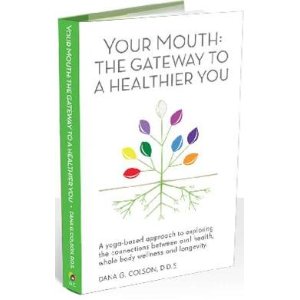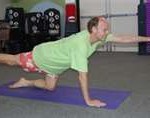By: Dr. Dana Colson, D.D.S
Reviewed by: Michael Bedard, Personal Trainer, MBA
Some books you read because you need to and other books you read because you want to. Your Mouth: The  Gateway to a Healthier You is one of those books that you need to and should want to read. Dr. Dana Colson, D.D.S. has done a marvellous job of taking the subject of oral health and making it hip, interesting and relevant to our overall health and well-being.
Gateway to a Healthier You is one of those books that you need to and should want to read. Dr. Dana Colson, D.D.S. has done a marvellous job of taking the subject of oral health and making it hip, interesting and relevant to our overall health and well-being.
The book is hip because what is more hip today than to shop at Lulu Lemon and go to yoga class? Dr. Colson successfully marries the holistic concepts of yoga to oral health. An excerpt from the chapter titled Yoga for the Mouth is a perfect example of this; “Yoga is also about the importance of small, conscious movements to strengthen our emotional and physical well-being. A minimally invasive approach to dentistry is the same. Using new technology, gentle orthodontic forces allow the bone to remodel itself slowly over time and regain better balance for teeth, muscle and soft tissue. Through these small movements and slow shifts, we are able to remodel our mouths at any age.” Read more…
Mindfulness means being aware, to focus your attention on what is talking place right now, fully and completely. It means to live in the moment, not to judge the moment but to see each moment as a new beginning, a new opportunity to start over, to tune in, and to reconnect.
Practicing mindfulness involves stopping all the “doing” in your life and relax into the present without trying to fill it up with anything. The goal is to purposefully allow your body and mind to come to rest in the moment, no matter what is “on” your mind or how your body feels. This means allowing yourself to be in the moment with things exactly as they are, without trying to change anything. Read more…
For as many people that exercise there are excuses not to continue to exercise. Some of these excuses are relatively legitimate. There are times in our lives that exercise just does fit, that it would cause too much stress to take the time to exercise or it would increase the risk of physical injury. However, these “legitimate excuses” are rare and in most cases people can modify their busy life and work schedule or the intensity of their exercise to make it work.
Excuses not to exercise can be classified as being externally or internally founded. Externally, excuses range from the gym is too far away, it is too hot/cold/wet, I have no one to work out with, my favourite instructor/personal trainer is away, work is too busy, my gym clothes are dirty etc., etc. 99.9% of these external excuses are easily managed with a little planning to your schedule and motivation to really want to exercise. Exercise is fun and most people agree that once they begin an exercise session they enjoy it and are glad they have made the effort to do it even if it meant changing or reprioritizing their schedule.
Read more…
Exercising is not hard, however, for many people, especially older adults, knowing how, when and where to start exercising is the challenge. Unfortunately, it is a common held belief that you need sophisticated equipment, or be a member of an expensive fitness facility to start exercising. This is simple just not the case.
Most people exercise every day by just walking but many don’t consider this “formal exercise”. Maybe that is because it is easy to do and something you can do any time, anywhere. But walking is an excellent form of cardiovascular exercise and walking has many other health benefits such as;
Read more…
A lack of muscle strength, increase stiffness of the joints and muscles, decrease agility, balance and coordination, increased emotional stress or a decreased ability to cope effectively with occupational and life stress are all associated with the 50+ adult. Yoga is ideally suited as a one stop fix it shop for many of these aliments. Read more…
agility, balance and coordination, increased emotional stress or a decreased ability to cope effectively with occupational and life stress are all associated with the 50+ adult. Yoga is ideally suited as a one stop fix it shop for many of these aliments. Read more…
Active Living and Wellness can be defined as the search for enhanced quality of life, personal growth and potential through positive life style behaviours and attitudes. If we take responsibility for our health and well-being, we can improve our health on a daily basis. The quality of our diet, the amount of regular exercise we get, our ability to handle stress effectively, the quality of our relationships with family and friends and our career success all have an influence on our state of wellness. Read more…
Wellness is a lifelong growth process that involves the integration of your mind, body and spirit. What you think, feel and believe has an impact on your health and well-being. Independence is of critical importance for the 50+ adult and a significant component of wellness.
Read more…
Reference: Full Catastrophe Living: Using the Wisdom of Your Body and Mind to Face Stress, Pain, and Illness
By: Jan Kabat-Zin, Ph.D.
Mindfulness means being aware, living intentionally, fully and completely, from moment to moment. It means to live in the moment, not to judge the moment but to see each moment as a new beginning, a new opportunity to start over, to tune in, and to reconnect.
Practicing mindfulness involves stopping all the “doing” in your life and relax into the present without trying to fill it up with anything. The goal is to purposefully allow your body and mind to come to rest in the moment, no matter what is “on” your mind or how your body feels. This means allowing yourself to be in the moment with things exactly as they are, without trying to change anything.
You need to practise mindfulness in order to reap its benefits (table 1). The more systematically and regularly you practice, the more the power of mindfulness will grow and the more of its benefits will be experienced.
Read more…
![Quality of Life Metrics-iStock_000016271349Small[1]](http://forever-active.com/wp-content/uploads/2012/01/Quality-of-Life-Metrics-iStock_000016271349Small11-300x199.jpg)
There are 4 components and 11 factors that constitute quality of life for the Older Adult. On the table below grade yourself on each of the factors. Any score less than a 3 would indicate that an improvement in this area is warranted and that you should strategize on how to improve this area in your life.
Read more…
Reference: Full Catastrophe Living: Using the Wisdom of Your Body and Mind to Face Stress, Pain, and Illness
By: Jan Kabat-Zin, Ph.D.
The focus you have when you practise mindfulness, paying attention to the present moment and seeing things as they are without trying to change them, through mediation is crucial. If your energy and commitment to practice is low, it will be hard to develop calmness and relaxation with any consistency.
As well, your attitude that you bring to the practice of mindfulness will, to a large extent, determine the long-term value of mindfulness. Keeping particular attitudes in mind is actually part of mindfulness training and sets the stage for what is possible by being mindful.
Read more…
 Gateway to a Healthier You is one of those books that you need to and should want to read. Dr. Dana Colson, D.D.S. has done a marvellous job of taking the subject of oral health and making it hip, interesting and relevant to our overall health and well-being.
Gateway to a Healthier You is one of those books that you need to and should want to read. Dr. Dana Colson, D.D.S. has done a marvellous job of taking the subject of oral health and making it hip, interesting and relevant to our overall health and well-being.




![Quality of Life Metrics-iStock_000016271349Small[1]](http://forever-active.com/wp-content/uploads/2012/01/Quality-of-Life-Metrics-iStock_000016271349Small11-300x199.jpg)